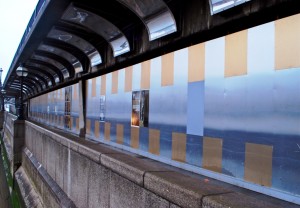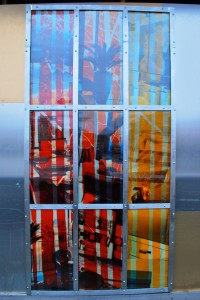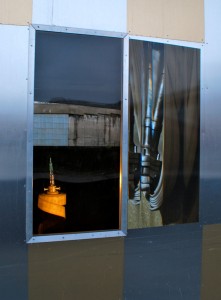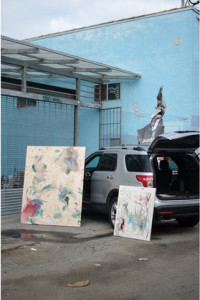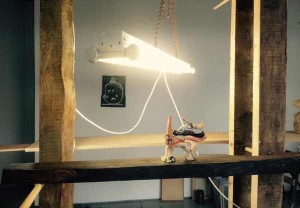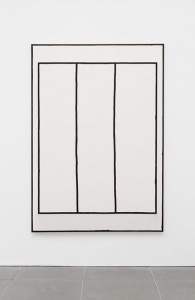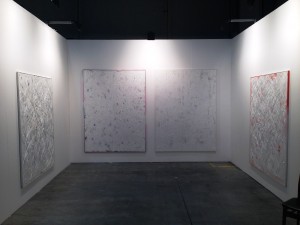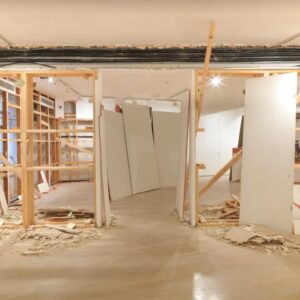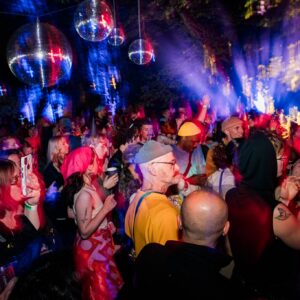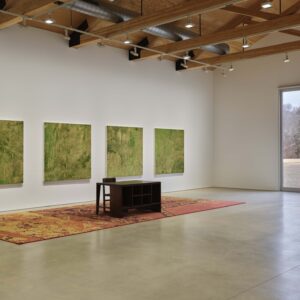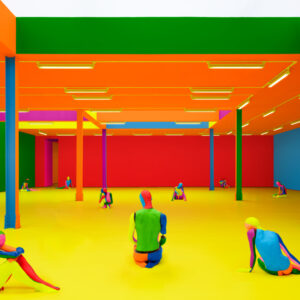No More Icons, Blackfriars Bridge hoarding, until 27th June 2012.
Those of us who are familiar with Blackfriars Bridge are also familiar with the ongoing construction in the area, as well as the Blackfriars ramp alongside it – a recent addition to the area, designed to improve accessibility and to help redevelopment.
A light reflecting hoarding was also installed for appearance’s sake, brightening up the space for passers-by.
This hoarding has been used as a temporary exhibition space in the past and is currently exhibiting a rather unique show of several installations from the Rod Barton Gallery.
The show is a collaboration of several artists, with works by Gabriele Beveridge, Giles Round, Jacob Farrell & Matthew Darbyshire, Peles Empire, and Rowena Harris. Consisting of five different sculptures and installations, the exhibition is entitled No More Icons, and plays on our society’s secularism and obsession with the consumption of iconography. Each work is clearly visible but only through a window, giving the viewer a single viewpoint and thus exposing the paradox of what it means to be iconic in contemporary culture.
In an interview with Rod Barton Gallery curator Carly McGoldrick, she explains that the idea to use icons for the exhibition was inspired by both the artworks and the space, but actually catalysed by the death of Elizabeth Taylor.
“I found it fascinating that in addition to seeing her face everywhere, there was widespread media coverage of the auctions selling her collections of art and jewellery. We were seeing her both through images and objects and these representative forms were outliving her.”
No More Icons takes this idea and deliberately points out the paradox of modern icons – they are considered icons as long as they are accessible and yet we can only access them in a two dimensional format.
By choosing the Blackfriars Hoarding as the exhibition site, the works challenge the audience to approach sculpture in a different way: It is not the typical kind of space one considers for a sculpture exhibition, as it is deceptive: The space is public, yet it is impossible to directly access the artworks. When asked about the choice of venue McGoldrick responded: “I was keen to address a new way of exhibiting these mediums, working from this core concept of accessibility. As a window gallery [the space] acknowledges readings of objects as commodity […] and yet consumer critique was never the main concern, as for me the artists address this as a reality”.
Another recent London exhibition that questions icons and their meaning is “Irwin: Time for a New State” at the Calvert22 foundation. A vast selection of works of art from Irwin, the visual arts component of the political arts collective NSK, (Neue Slovenische Kunst) is being exhibited for the first time in the UK. The works are focused around folk imagery and symbolism, some of which are grouped together like Russian religious icon frames would have been. By appropriating various symbols as source elements, IRWIN questions the way we attach meaning to visual symbols we come across.
McGoldrick points out that while Calvert 22’s exhibition is very much rooted in Eastern European history and totalitarianism, “In “No More Icons” [she] define[s] the contemporary icon as a celebrity, i.e. a real person […] however I deliberately use the word icon as a construct due to its several definitions. This plurality is referenced in the exhibition, where the icon is positioned as something that was one considered to be sacrilege, often created from expensive materials, but now can be reproduced and stylised with ease, in the form of images and objects that are altered to look a certain way.”
To illustrate this, McGoldrick uses a piece entitled “hose4 (2012)” by Peles Empire as an example. Peles Empire is a collaborative work by artists Katherine Stoever and Barbara Wolff, taking its name from a Romanian castle that displays different architectural styles of the past centuries.
Stoever and Wolff have reproduced several rooms of the castle as part of an ongoing investigation into the copy, and two-dimensional transformations of three-dimensional objects, turning them into imagery.
For No More Icons the duo have chosen to emphasise the nature of the venue, combining different forms of reproduction of a fire hose. As McGoldrick explains, the function of the fire hose thus becomes redundant, shifting from a utilitarian object to a stylised and fetishised facade.
The Rod Barton gallery thus creates an exhibition that encapsulates modern society’s shift in value yet also references a more classical style of sculpture. By reusing or distorting recognisable daily objects, we are forced to confront and question what it means to be an icon – which, according to McGoldrick is “to be experienced as a representation as opposed to in person.”
